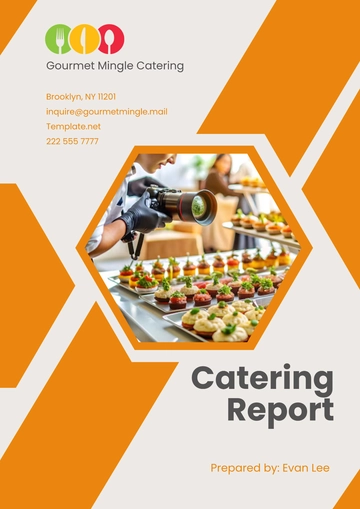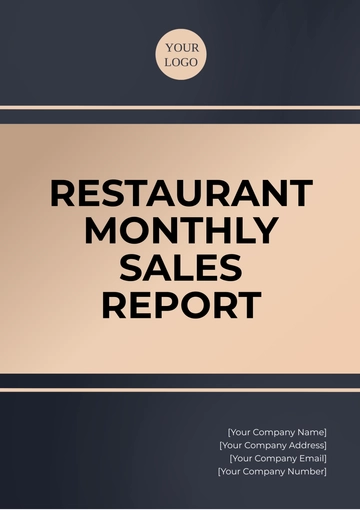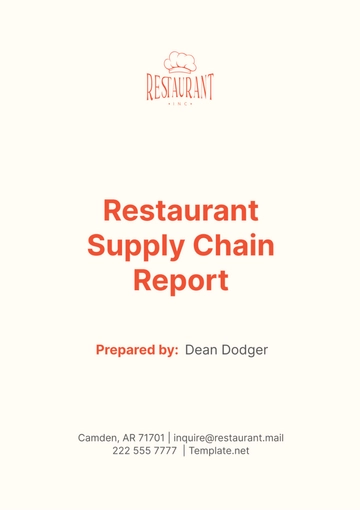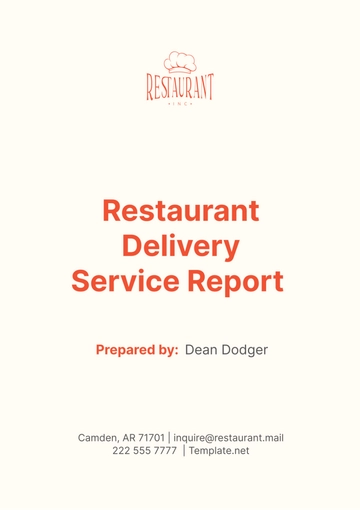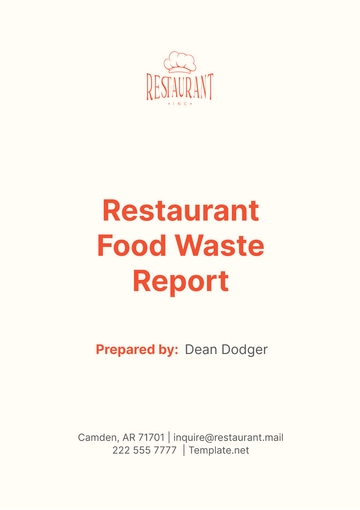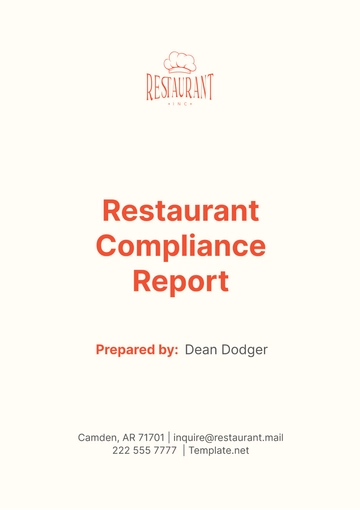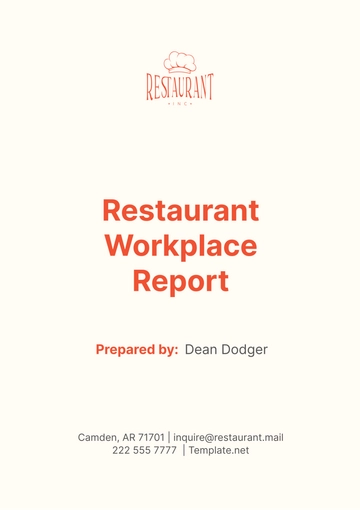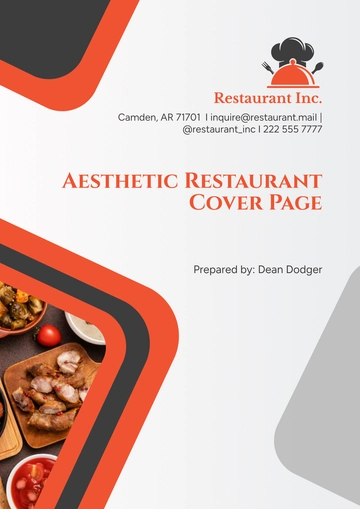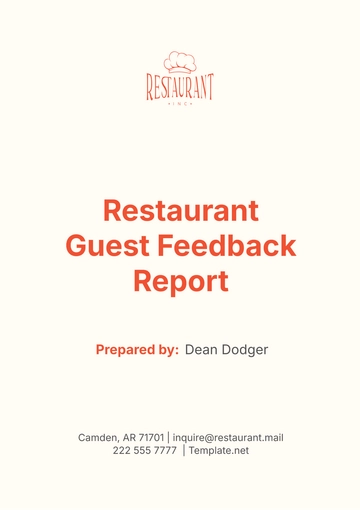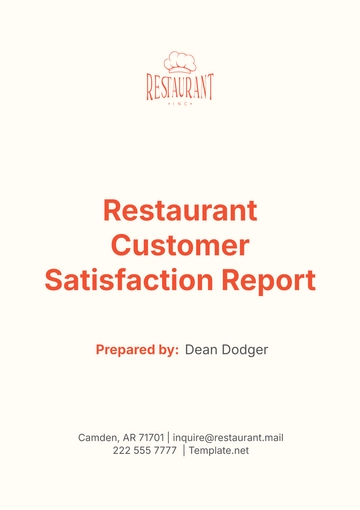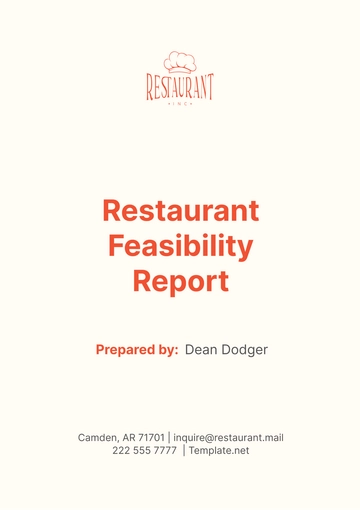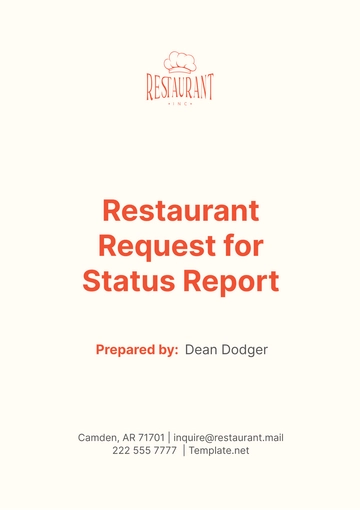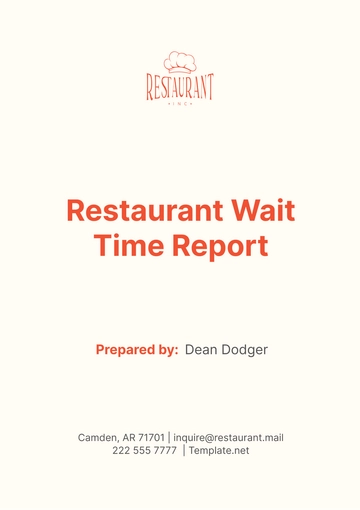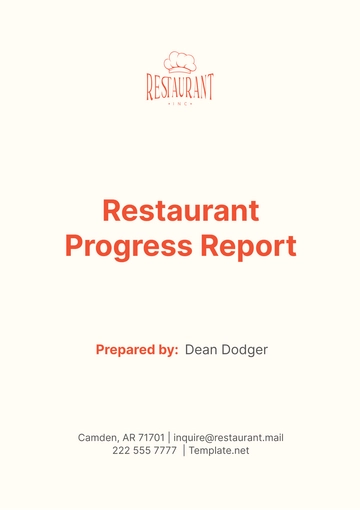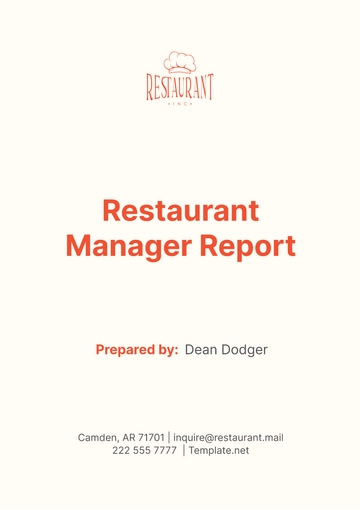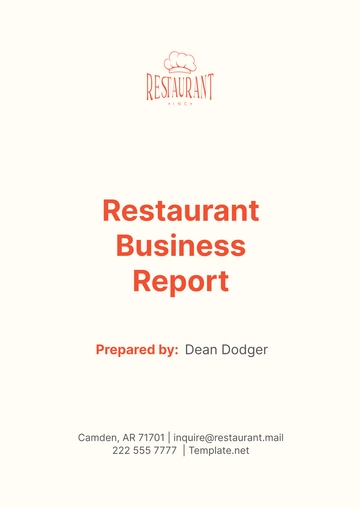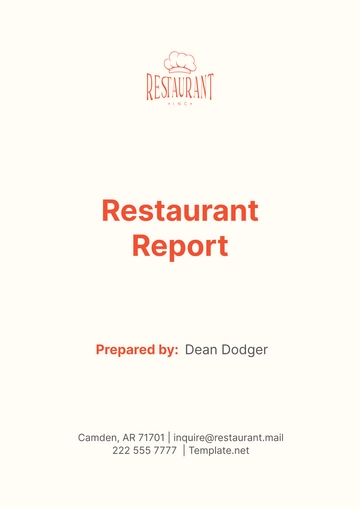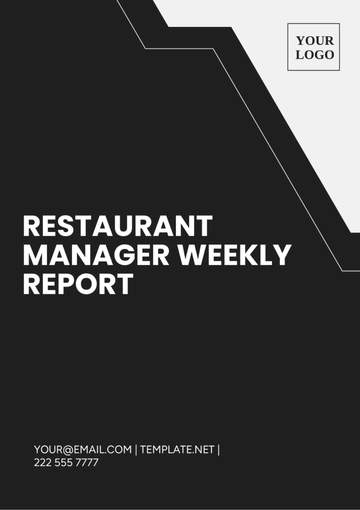Free Restaurant Business Report
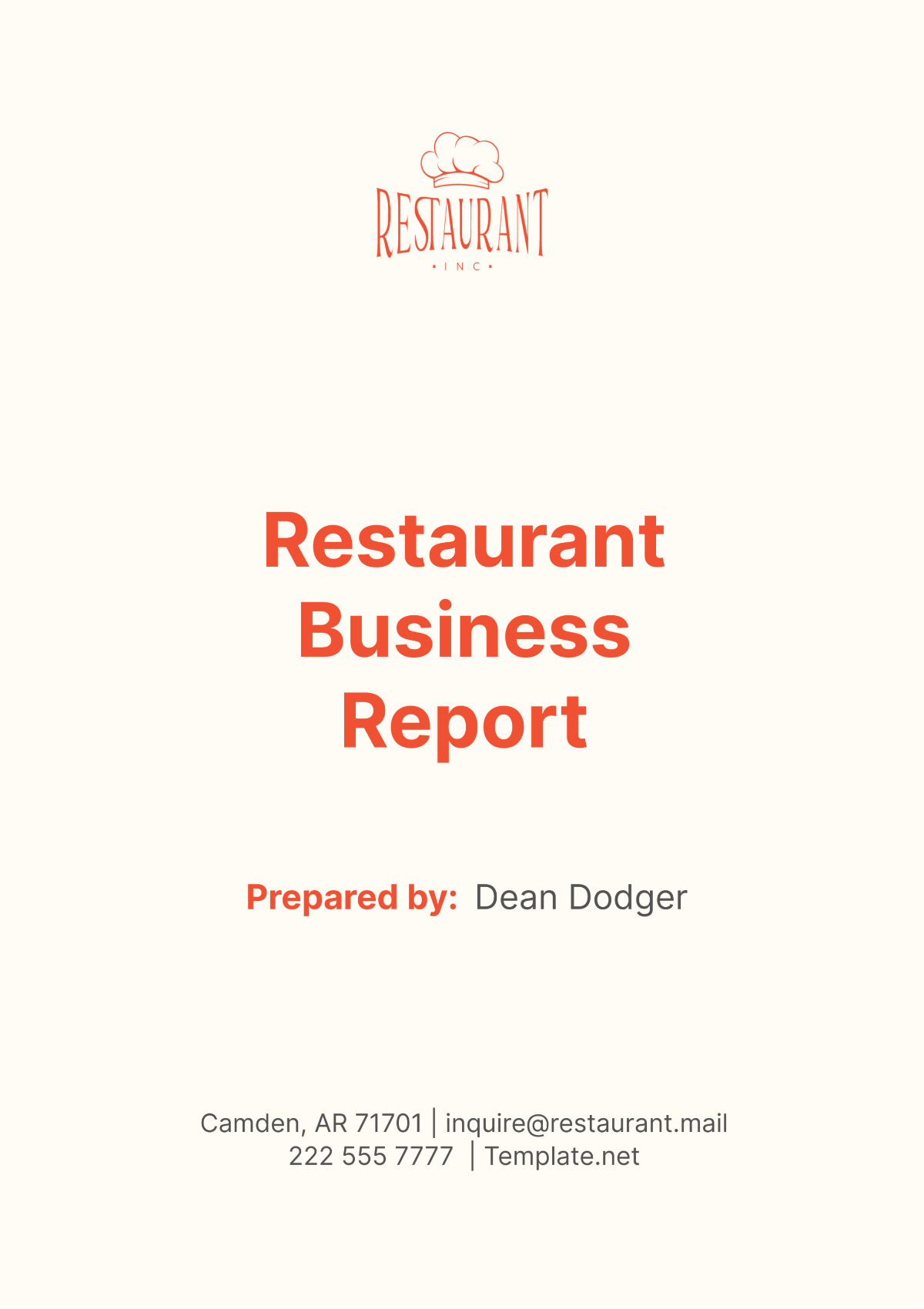
I. Executive Summary
[Your Company Name], a renowned restaurant, witnessed a prosperous month in January 2024, marked by notable achievements and promising growth opportunities. Despite facing challenges such as escalating ingredient costs and labor expenses, the restaurant's strategic initiatives and customer-centric approach propelled it towards success. This report provides a comprehensive analysis of [Your Company Name]'s financial performance, sales dynamics, cost structures, customer feedback, operational efficiency, and future outlook.
II. Financial Performance
Throughout January 2024, [Your Company Name] demonstrated robust financial performance, reflecting the effectiveness of its revenue generation and cost management strategies. Total revenue for the month amounted to $50,000, indicating a significant increase compared to the previous month. This growth was primarily driven by a surge in customer traffic, supported by targeted marketing campaigns and menu innovations.
The breakdown of financial metrics is as follows:
Metric | Amount |
|---|---|
Total Revenue | $50,000 |
Cost of Goods Sold | $15,000 |
Gross Profit | $35,000 |
Operating Expenses | $20,000 |
Net Profit (Loss) | $15,000 |
The gross profit margin remained healthy at 70%, reflecting the restaurant's ability to efficiently manage its cost of goods sold. However, operating expenses, including labor costs, rent, utilities, and other overheads, amounted to $20,000, posing a challenge to maintaining profitability amidst rising costs.
III. Sales Analysis
A detailed analysis of sales distribution across various product categories provides insights into consumer preferences and purchasing behavior. In January 2024, sales were distributed as follows:
Category | Sales Amount ($) | Percentage of Total Sales |
|---|---|---|
Food | $35,000 | 70% |
Beverages | $10,000 | 20% |
Desserts | $5,000 | 10% |
Food: Food items drove 70% of total sales, indicating strong demand and emphasizing the need for continual menu refinement.
Beverages: Beverages contributed 20% of sales, presenting upselling opportunities and highlighting the importance of a diverse beverage selection.
Desserts: Desserts accounted for 10% of sales, showcasing their role in enhancing the dining experience and suggesting potential for menu innovation.
Overall Insights: The balanced revenue mix across categories suggests a diverse menu selection, with opportunities for growth in beverage and dessert sales through strategic initiatives.
IV. Cost Analysis
A thorough analysis of costs incurred by [Your Company Name] during January 2024 sheds light on expenditure patterns and areas for optimization. The breakdown of expenses is as follows:
Expense Category | Amount ($) |
|---|---|
Cost of Ingredients | $12,000 |
Labor Costs | $8,000 |
Rent | $5,000 |
Utilities | $2,000 |
Other Expenses | $3,000 |
Cost of Ingredients: Accounting for $12,000, ingredient costs represent a significant portion of expenses, underscoring the importance of efficient sourcing and inventory management.
Labor Costs: Labor expenses amounting to $8,000 highlight the need for effective workforce management to optimize productivity while controlling costs.
Rent: With rent expenses totaling $5,000, prudent cost control measures and negotiation strategies are crucial for minimizing overhead expenses.
Utilities: Utilities costs of $2,000 underscore the importance of energy efficiency and operational optimization to mitigate expenses.
Other Expenses: Miscellaneous expenses totaling $3,000 emphasize the need for careful scrutiny and optimization of all operational costs to improve overall profitability.
V. Inventory Management
Effective inventory management is crucial for minimizing waste, optimizing stock levels, and controlling costs. Key inventory metrics for January 2024 are as follows:
Metric | Value |
|---|---|
Inventory Turnover | 12 times |
Inventory Levels | $7,000 |
Potential Waste | $500 |
Inventory Turnover: With an inventory turnover rate of 12 times, efficient replenishment and utilization ensure freshness and minimize overstocking.
Inventory Levels: Maintaining inventory levels at $7,000 strikes a balance between stock availability and capital tied up, optimizing working capital utilization.
Potential Waste: Despite efforts, potential waste of $500 highlights the ongoing need for waste minimization strategies through portion control and inventory tracking.
VI. Customer Feedback and Satisfaction
Customer feedback serves as a valuable source of insight into the dining experience and can inform strategic decisions aimed at enhancing customer satisfaction and loyalty. In January 2024, [Your Company Name] received overwhelmingly positive feedback from patrons, as evidenced by the following metrics:
Metric | Value |
|---|---|
Average Customer Rating | 4.5 / 5 |
Percentage of Positive Feedback | 90% |
Average Customer Rating: Achieving an average rating of 4.5 out of 5 reflects the restaurant's commitment to excellence and indicates high levels of customer satisfaction.
Percentage of Positive Feedback: With 90% positive feedback, the restaurant's customer-centric approach and dedication to exceeding expectations are evident, fostering strong customer loyalty and retention.
VII. Marketing and Promotions
Strategic marketing initiatives and promotions play a vital role in driving customer engagement, increasing brand visibility, and stimulating sales. The effectiveness of [Your Company Name]'s marketing efforts during January 2024 is summarized below:
Campaign/Promotion | ROI |
|---|---|
Social Media Campaign | 15% |
Email Newsletter | 20% |
Special Discounts | 10% |
Social Media Campaign: Boasting a 15% ROI, the social media campaign effectively engaged the target audience, enhancing brand awareness and driving traffic to digital platforms.
Email Newsletter: With a 20% ROI, the email newsletter successfully nurtured customer relationships, driving repeat business and encouraging customer retention.
Special Discounts: Despite a modest 10% ROI, special discounts stimulated sales and customer acquisition, demonstrating the effectiveness of targeted promotions in boosting revenue.
VIII. Operational Efficiency
Operational efficiency is critical for ensuring smooth restaurant operations, optimizing resource utilization, and delivering consistent service quality. Key operational metrics for January 2024 are as follows:
Metric | Value |
|---|---|
Table Turnover Rate | 3 times/hr |
Average Order Fulfillment Time | 15 minutes |
Staff Productivity | 80% |
Table Turnover Rate: Achieving a rate of 3 times per hour optimizes dining space utilization, maximizing revenue-generating opportunities during peak hours.
Average Order Fulfillment Time: A swift fulfillment time of 15 minutes enhances the dining experience, ensuring prompt service and customer satisfaction.
Staff Productivity: With an 80% productivity rate, effective workforce management practices optimize labor utilization, minimizing idle time and operational costs.
IX. Trends and Forecasting
Trends analysis and forecasting play a pivotal role in guiding strategic decision-making and anticipating future opportunities and challenges for [Your Company Name]. By analyzing historical data and market trends, as well as considering external factors such as economic conditions and consumer preferences, the restaurant can develop informed strategies to sustain growth and maintain competitiveness.
A. Trends Analysis:
Sales Trends: Analyzing sales trends over multiple periods allows [Your Company Name] to identify patterns and fluctuations in customer demand, enabling better inventory management and resource allocation.
Customer Behavior: Understanding evolving customer preferences and behaviors provides insights into menu preferences, dining habits, and service expectations, guiding menu innovation and marketing strategies.
Market Conditions: Monitoring industry trends, competitor activities, and market dynamics helps [Your Company Name] stay abreast of changes in the competitive landscape and adapt its strategies accordingly.
B. Forecasting:
Revenue Projection: Utilizing historical sales data and trend analysis, [Your Company Name] can forecast future revenue streams, enabling accurate financial planning and budgeting.
Demand Forecasting: By forecasting demand for specific menu items and services, [Your Company Name] can optimize inventory levels, staffing, and operational resources to meet customer needs effectively.
Market Expansion Opportunities: Forecasting trends in consumer demographics and market demand enables [Your Company Name] to identify potential expansion opportunities, whether through new locations, delivery services, or catering offerings.
Risk Assessment: Anticipating potential risks and challenges, such as economic downturns, supply chain disruptions, or changes in consumer preferences, allows [Your Company Name] to develop contingency plans and mitigate potential impacts on business operations.
C. Strategic Recommendations:
Menu Innovation: Based on trends analysis and customer feedback, [Your Company Name] can prioritize menu innovations and product enhancements to meet changing consumer preferences and differentiate itself in the market.
Marketing Strategies: Tailoring marketing strategies and promotional campaigns to align with emerging trends and consumer behaviors enhances customer engagement and brand relevance, driving sales and loyalty.
Operational Enhancements: Forecasting demand and operational requirements enables [Your Company Name] to streamline processes, optimize resource allocation, and improve operational efficiency, ultimately enhancing customer satisfaction and profitability.
Sustainability Initiatives: Identifying trends towards sustainable and ethical dining practices allows [Your Company Name] to proactively integrate sustainability initiatives into its operations, appealing to eco-conscious consumers and future-proofing the business.
X. Conclusion
In conclusion, [Your Company Name]'s performance in January 2024 reflects its commitment to excellence, innovation, and customer satisfaction. Despite facing challenges such as rising costs, the restaurant has demonstrated resilience and adaptability, leveraging its strengths to drive growth and profitability. Moving forward, strategic initiatives focused on cost optimization, customer engagement, and operational efficiency will be key to sustaining [Your Company Name]'s success and maintaining its position as a leading culinary destination.
- 100% Customizable, free editor
- Access 1 Million+ Templates, photo’s & graphics
- Download or share as a template
- Click and replace photos, graphics, text, backgrounds
- Resize, crop, AI write & more
- Access advanced editor
Analyze and strategize with Template.net's Restaurant Business Report Template. Editable in our AI Editor Tool, this customizable template ensures clarity and professionalism in your reports. Crafted for accuracy and impact, it streamlines your data analysis process, covering financials, operations, and marketing insights. Elevate your restaurant's performance with this essential resource.
You may also like
- Sales Report
- Daily Report
- Project Report
- Business Report
- Weekly Report
- Incident Report
- Annual Report
- Report Layout
- Report Design
- Progress Report
- Marketing Report
- Company Report
- Monthly Report
- Audit Report
- Status Report
- School Report
- Reports Hr
- Management Report
- Project Status Report
- Handover Report
- Health And Safety Report
- Restaurant Report
- Construction Report
- Research Report
- Evaluation Report
- Investigation Report
- Employee Report
- Advertising Report
- Weekly Status Report
- Project Management Report
- Finance Report
- Service Report
- Technical Report
- Meeting Report
- Quarterly Report
- Inspection Report
- Medical Report
- Test Report
- Summary Report
- Inventory Report
- Valuation Report
- Operations Report
- Payroll Report
- Training Report
- Job Report
- Case Report
- Performance Report
- Board Report
- Internal Audit Report
- Student Report
- Monthly Management Report
- Small Business Report
- Accident Report
- Call Center Report
- Activity Report
- IT and Software Report
- Internship Report
- Visit Report
- Product Report
- Book Report
- Property Report
- Recruitment Report
- University Report
- Event Report
- SEO Report
- Conference Report
- Narrative Report
- Nursing Home Report
- Preschool Report
- Call Report
- Customer Report
- Employee Incident Report
- Accomplishment Report
- Social Media Report
- Work From Home Report
- Security Report
- Damage Report
- Quality Report
- Internal Report
- Nurse Report
- Real Estate Report
- Hotel Report
- Equipment Report
- Credit Report
- Field Report
- Non Profit Report
- Maintenance Report
- News Report
- Survey Report
- Executive Report
- Law Firm Report
- Advertising Agency Report
- Interior Design Report
- Travel Agency Report
- Stock Report
- Salon Report
- Bug Report
- Workplace Report
- Action Report
- Investor Report
- Cleaning Services Report
- Consulting Report
- Freelancer Report
- Site Visit Report
- Trip Report
- Classroom Observation Report
- Vehicle Report
- Final Report
- Software Report
